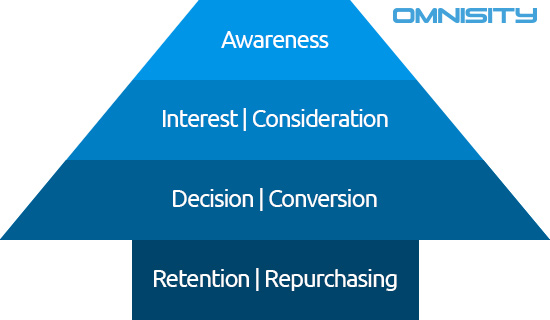Some of us focus on determining successful content purely through conversions, though conversions are our ultimate goal and what keeps us afloat focusing all of our efforts simply on conversion centric content is unlikely to lead to success as it can narrow your potential audience.
How to identify content purpose and audience
Even before starting to write content, understanding the area’s and customer base you are intending to target is key to ensuring you are on the right path and that the content you intend to create will be relevant to the PERSON you are targeting.
As an example, in this instance, we target SMEs who are trying to tackle areas of their own online demons. We know that our demographic is SMEs, so rather than just firing off content blindly we need to analyse the marketing and research both the potential audience and what the SME’s can benefit out of it. From this we can create content that is relevant and of interest to the target audience.
Customer Buying Cycle
What is the buying cycle?
The buying cycle is the process someone may go through when they’re looking to buy or simply have interest in a product or service.
A customer at the awareness stage isn’t necessarily looking for a specific product or service. This stage refers to making potential customers aware of your business and what you do or sell.
Using web design as an example, the visitor may not be on the market for having a new website developed but instead is looking for information about a particular issue. i.e. mobile responsiveness. An appropriate article at this stage would offer facts and information on the importance of mobile responsive websites, why they are important for SERPS and usability.
While your audience at this stage are unlikely to convert, you are still targeting a specific and relevant audience in the right way and in turn building brand, product, service awareness.
At the next stage, your audience is likely to be looking for a problem to a specific solution.
For example, a tool manufacturer is looking to generate traffic from visitors that requires tooling but are not exactly sure about the best material to have the tools made from. Research from Propel Growth shows that 92% of buyers don’t consider themselves experts in solving a problem and they turn to content for the answers.
An example piece of content would be creating a ‘material guide’ showing the strengths and weaknesses of the materials and what tools can be manufactured from each.
At this stage you’ve turned an ‘awareness’ visitor into a potential customer that you can potentially convert; you’ve provided useful content to gain trust and given advice on the products that they need to solve their problem.
This is one of the most important areas of the buying cycle. Ultimately, it’s what makes your client or business money. While it’s not the goal of every article or content you create, failing at this stage makes any effort you have put into creating relevant content wasted. There are a number of steps you can follow to ensure that the content throughout your website is geared towards conversion:
Including;
- Content offering advice and how to guides for specific products or services
- A balance between ‘informative’ and ‘promotional’ throughout. Don’t forget visitors need a ‘reason to buy’ and a ‘close’ on any sales pitch
- Using visual media for product pages (i.e. promotional product videos)
- Ensure content is engaging. Consider the length of the content, tone, and level of detail.
- Make sure the content is in line with page design and keep the content punchy but not too short and not too long.
Once you’ve converted, the challenge doesn’t end there! The next step is customer retention. Particularly important if your average order values are relatively low, but still key for higher order values, you need to ensure your hard work engaging customers and guiding them to conversion doesn’t end at the checkout page.
Email marketing can play an essential role in this area. Everything from useful reminders on products a customer has already purchased to intensify. Promotional offers or discounts can grab your existing customer’s attention and drive them back to your website for their next purchase.
Actions points. What’s next?
The first step before implementing any strategy in line with the buying cycle is to determine what your key requirements are as part of your marketing plan. Lack of traffic but good engagement with service pages or products can indicate the awareness stage is your main issue; good traffic but poor engagement would suggest consideration and conversion content should be your focus.
Identify your goals and develop a content plan for specific requirements. Put in place a method of tracking these end results. For example, analysing click-through rates from a post to product or service page and then monitor the conversion rates.




